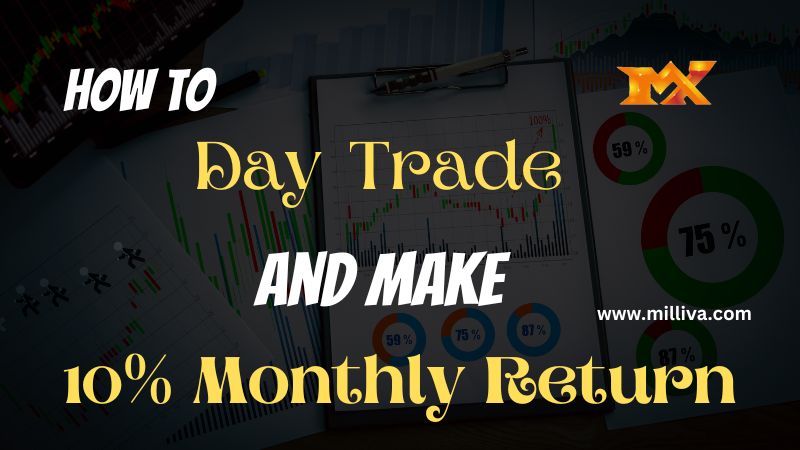How to Day Trade Forex and Make 10% Monthly Return

![]()
The ultimate goal of most day trade forex is to be able to leave their jobs and support themselves through the markets. Two ways exist for day traders to earn a living:
To generate a respectable monthly income. You may start with a sizable amount of capital and get a modest percentage return. This calls for more money but fewer skills.
The alternate strategy is to begin with less money, say $10,000 to $30,000, and produce larger returns in order to survive. Less money is needed, but skill is far more important.
The roadmap for increasing your returns to 10% or higher each month is provided below. By doing this, even if you start with $10,000, you’ll be making at least $1,000 every month, and that income will increase as your investments and/or returns increase.
Equip your trading strategy around the strategies covered below, whether you day trade equities, foreign exchange, or futures. You might be one of the few traders (compared to others who try). Who can make a career from day trading with dedication and practise over the course of six months to a year.
How Long Does It Take to Succeed in day trade forex?
Be aware of your obstacles before trying to make a living day trading. Numerous people are drawn to day trading, however the majority won’t even turn a profit, let alone make a life. Most people who try day trading end up losing most, if not all, of their initial trading account deposits.
Few day traders would be able to support themselves through day trading. The likelihood of earning a fantastic livelihood is substantially lower. For people who depend on the markets for their livelihood. It normally takes them six month to a year to get there. After devoting full-time hours (about 30 to 40 hours per week) to learning, training, and trading.
The guide that follows will assist you in becoming one of the select traders. Who can generate returns of 10% or more from the market each month while day trading.
Success in Day Trading is Now Limited to Four Numbers
You can become a successful trader if you develop or adhere to a strategy. That enables you to maintain these statistics within the desired ranges. Four parameters can be used to define successful trading: number of trades, win rate, reward-to-risk ratio, and risk on each trade (position size).
Your ability to day trade for a living will be aided by your understanding of these four numbers. The parts and numbers all function together.
Risk Capital per Trade in
Manage the risk on each trade for success. A maximum of 1% of your account may be at risk for each trade. If your account has $10,000, for instance, you can risk up to $100 on each trade.
To ensure that you don’t lose more than 1% of your account, place a stop-loss order. Once you are aware of your entry price and stop-loss level, determine the size of your trade (how many shares, lots, or contracts you take in the stock market, forex market, or futures market).
Although one percent may not seem like a significant amount to risk, winning trades should always outweigh losing deals. While you only take a 1% chance, you aim to win 1.5% to 3% of your bets, thus for example, you might take a $100 chance and hope to gain $150 to $300. By only taking 1% of your cash at risk, you won’t lose much money even if you experience a losing run of five to ten trades. After a few profitable transactions, you will have recovered your loss. A losing streak can wipe out your account if you take a risk more than 1%, though.
Reward-to-Risk
The reward-to-risk ratio is the difference between your profit from winning trades and your loss from losing ones. Your reward-to-risk ratio should be at least 1.5 to 1 if you consistently risk 1% of your capital. Accordingly, you profit 1.5% (or more) on trades that are winners and lose 1% on trades that are losers.
Put a profit objective farther away from your entry point than your stop loss is in order to achieve this. For instance, if you purchase a stock for $10 and set a stop loss at $9.95, your target price would need to be set close to $10.08. Based on the size of your position, this risk would amount to about 1% of your account capital. If you lose, each share costs you $0.05, but if you win, each share is worth $0.08. 1.6 to 1 or an inverse reward-to-risk ratio of 0.08 to 0.05. The ratio of rewards to risks and win rate are related.

Percentage of Win Rate
The number of trades you win, represented as a percentage, is your win rate. Your win percentage is 53% if you place 100 transactions in a demo account and win 53 of them. Win rate and reward-to-risk are related.
If the reward-to-risk ratio on each trade is 1.5 to 1 or above, day traders will be lucrative if they maintain a win rate of close to 50% or above.
Let’s say you can sustain a reward-to-risk ratio of 1.5 across 100 deals. On winning trades, you gain 1.5%, and on losing trades, you lose 1% of your account capital.
You are doing well if you win 50% of your trades:
50 x 1.5% = 75% – (50 x 1%) = 25%
Over those 100 shares, you enhance your account capital by 25%. You won’t make any money if only 40% of your trades are profitable.
40 × 1.5% – (60 x 1%) = 0%
Do you notice the connection between victory rate and reward to risk? Try to increase your win rate to 50% or greater by making tiny adjustments to your strategy if you now only win 40% to 50% of your transactions. As an alternative, you may attempt gently lowering risk or slightly raising reward to increase benefit-to-risk. This break-even or losing technique may become lucrative with little tweaks.
Amount of Trades
According to the data above, your objective is to make at least 1.5% more than the 1% you are risking on each transaction and win more than 50% of your deals. The more transactions you make if you can accomplish that while maintaining those numbers, the better.
There would be around 21 trades each month if you made one trade per day.
1 With a 1.5 reward-to-risk and a 50% win rate, you would get 11 x 1.5% – (11 x 1%) = 5.5%. If you place two trades per day, your percentage return rises to 11% for the month even though you make 22 wins and 22 losses.
You should be able to find between two and six trades per day that will allow you to maintain the aforementioned statistics even if you only trade for the two hours required to make a living from the markets (this is the end result; initially, you should put in at least several hours per day of study and practise). Be aware that some day’s result in no trades since the market is unfavourable, while other days could result in ten trades. If you maintain the aforementioned metrics and make four trades on average every day, your monthly return on investment will be 22%.
However, refrain from entering trades merely for the sake of entering deals—this will not boost your profit. Every trade you make needs to be a part of a plan that increases your chance of winning by at least 50% and has a risk-to-reward ratio of 1.5 or higher. Your statistics will suffer if you enter trades with a low likelihood of success or if the reward does not outweigh the risk, which could result in a lesser return or a loss.

Visit us on: www.milliva.com





